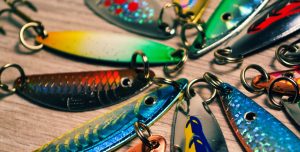Fishing with spoons during the fall and winter seasons can be incredibly rewarding. This classic lure offers versatility and success across various species, from bass to trout, pike, and walleye. As the water temperatures drop, fish behavior changes, making spoon selection and presentation key to success.
1. Why Spoons Work in Cold Weather
Spoons excel in colder months because they mimic the movement of baitfish, a primary food source in fall and winter. In fall, baitfish begin to slow down, and many fish species like bass and trout enter feeding frenzies in preparation for winter. The flashy, erratic action of a spoon closely imitates the dying or wounded baitfish, which is irresistible to predators.
In winter, fish metabolism slows, and spoons can be fished more deliberately, imitating lethargic prey. The metal’s reflective quality catches light even in murky or low-visibility water, helping to draw fish from a distance.
2. Choosing the Right Spoon
Not all spoons are created equal, and selecting the right one depends on the water conditions and the fish being targeted.
- Size and Weight: Larger spoons, like ¾ to 1-ounce models, work well for deep-water fishing in cold weather, especially when vertical jigging for species like lake trout. Lighter spoons in the ¼ to ½-ounce range are ideal for casting in shallow water or over structure where bass and walleye might be holding.
- Color: In the fall, gold and copper spoons work best when mimicking the coloration of baitfish like shad or perch. For winter, silver or white spoons tend to produce better results, especially in clear water conditions. Darker colors may be more effective in murky water.
- Shape: The shape of the spoon can influence its action. Wider spoons produce a wobbling motion, which is great for covering water quickly. Thinner spoons, on the other hand, tend to fall faster, making them ideal for vertical jigging.
3. Presentation Tips for Fall
In the fall, fish are generally more aggressive, so covering water is important. Casting spoons over flats, drop-offs, and submerged structures is an effective way to locate feeding fish. A steady or erratic retrieve can mimic a wounded baitfish, but adding occasional pauses during retrieval can entice fish to strike, especially bass and pike.
Another effective technique is “yo-yo” retrieval. This involves allowing the spoon to sink, then reeling up quickly before allowing it to fall again. This creates an erratic, darting action that can trigger bites from predatory fish.

4. Winter Spoon Techniques
Winter fishing with spoons requires a slower, more deliberate approach. Fish tend to congregate in deeper, warmer parts of the water column. Vertical jigging is an excellent technique in these conditions. Once a school is located on a fish finder, dropping the spoon directly above the fish and lightly bouncing it off the bottom can result in strikes.
Letting the spoon sink to the bottom, followed by a slow lift and drop, will create subtle movements, mimicking the slow-moving prey fish typical in colder months. Keep an eye on the line, as bites can be soft and easily missed.
5. Gear Recommendations
When fishing with spoons, pairing the right rod and reel setup is essential for maximizing performance. A medium or medium-heavy rod with a fast action tip works well for both casting and jigging spoons. Spinning reels spooled with 8-12 lb fluorocarbon or braid are ideal since these lines offer sensitivity, which helps detect soft winter bites.
In winter, using lighter spoons can benefit from ultra-sensitive setups, helping anglers feel subtle strikes from lethargic fish.
6. Best Species for Spoon Fishing in Fall and Winter
- Bass: Particularly in the fall, bass are aggressively feeding before winter. Shallow structures and submerged vegetation are prime areas to cast spoons.
- Pike: These aggressive predators respond well to the flash of a spoon, especially in shallower water during late fall.
- Walleye: Walleye are a popular target for ice anglers. Jigging spoons near drop-offs or deep channels often yields success.
- Trout: Both lake and river trout respond to spoons, particularly in deeper waters during the winter.
Using spoons in the fall and winter offers versatility and consistent success. Understanding the right techniques and gear for the season can lead to productive days on the water.
Image: specialmatetackleboxes





